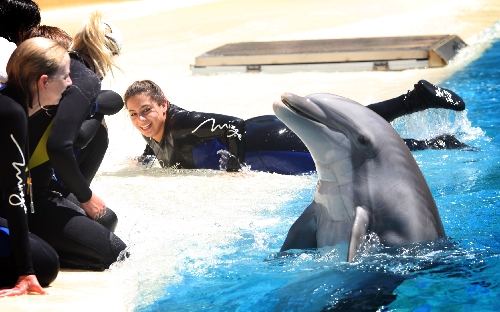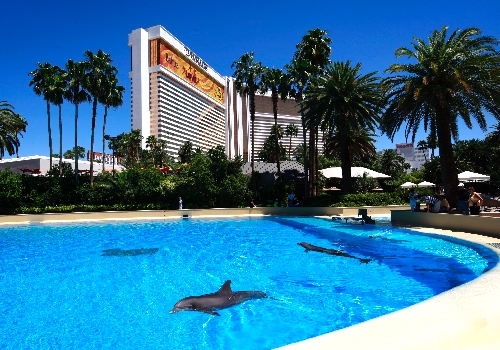Mirage Dolphin Habitat serves as attraction, research facility
Each time Duchess and her baby, K2, swam by the window separating the dolphins' pool from the humans' observation room, she watched the people as they watched her.
Maybe there was a bit of anthropomorphizing going on but that dolphin had a look in her eye, like she could tell you a thing or two if you only spoke her language. Not right now, though. Now, she had to teach her baby how to swim laps around the pool as fast as possible.
There was no need to teach K2 how to attract attention as the new calf, born at The Mirage Dolphin Habitat July 3, has been getting plenty of that. K2 was the first of two baby dolphins born this summer. The latest one, born Aug. 20, has yet to be named.
In the facility's underground viewing area on a recent Wednesday, a crowd of visitors jostled for position in front of the window that provided the best view of K2 and its mother. Parents held children up so they could see firsthand the animals they had only seen in pictures or movies before today.
People smiled and pointed at each flip of a tail fin but it was the dolphins' smiling, gray and white faces that drew the biggest reaction from the audience. "Oohs" and "ahhs" were mixed in with amazed disbelief.
It's kind of weird, one woman said to her companion, that you can see dolphins in the desert.
While Las Vegas is certainly a long way from the natural habitat of the animals, their presence here makes perfect sense for a facility that claims research and education to be its main purposes, says David Blasko, director of The Mirage's department of animal care.
"The Mirage Dolphin Habitat was built to educate people about dolphins," Blasko says of the attraction, which opened in 1990. "The goal is to get kids who go through here to learn about dolphins and to teach them how what they do affects the oceans."
Over the years, the staff has conducted research with the University of Nevada, Las Vegas, Texas A&M University and the University of Ohio. They have studied assisted reproduction in dolphins, starting a dolphin semen bank 10 years ago to help diversify the gene pool for breeding, Blasko says. The habitat also has worked with the U.S. Navy to study the effects of sonar and ship noises on dolphins. An animal husbandry committee vets all research proposals and selects those that the habitat will participate in.
Since opening, the habitat has experienced its share of controversy. In 2004, The Mirage hired outside experts to audit the exhibit. Eleven of 16 dolphins had died since 1990, most because of natural causes. Animal rights' groups have spoken out about the presence of dolphins in the desert. In 2005, the hotel came to an undisclosed agreement with the USDA, which sets and enforces standards that animal exhibitors must meet. Voluntary changes were made to the way the dolphins were cared for.
The habitat is inspected at least once a year by a USDA inspector, says Dave Sacks, spokesman for the agency. The dolphin habitat has been inspected five times since 2009, most recently in September, 2010. It passed each one.
Because the habitat's focus is educational, the dolphins don't perform aquarium-style shows. Visitors who pay the $17 admission will be able to walk around and watch the dolphins swimming or the trainers interacting with them. That's as close to a show as they get.
Those who want a more personal experience can pay $550 to be a trainer for a day. The program enables guests to "work" as a trainer, feeding the dolphins and learning commands to give them. Participants also can swim with the dolphins by grasping their dorsal fins. The package includes a continental breakfast, a three-course lunch, photos, admission to the habitat and Siegfried & Roy's Secret Garden, as well as a T-shirt.
The staff interacts with all guests, providing dolphin facts and figures for those who want more than just a glimpse of these marine mammals. At any given time, visitors may be able to watch as one of 12 dolphin trainers performs a variety of routines with the dolphins, running them through natural behaviors that they perform in the wild. When a dolphin flips into the air, it's not doing a trick, says curator of dolphin care Philip Admire. It's doing what it does in its natural ocean environment.
"Dolphins are a puzzle you have to figure out on a daily basis," says Admire, who has been working with the animals for 23 years.
Most of the trainers have bachelor's degrees; Admire, a former U.S. Marine, has a degree in biology. You won't get rich working as a dolphin trainer so you've got to a have a real love of the animals and a desire to advocate for them, he says.
As curator of dolphin care, Admire's duties include overseeing the health and well-being of the dolphins, conducting staff development, teaching behavioral techniques to the staff and helping to develop educational programs for the dolphins.
Dolphins are intelligent with well-developed personalities and, like humans, they can have good and bad moods. This may cause people to project human characteristics on them but that's a mistake, Admire says. And just because they look friendly and are depicted in the media as human-friendly animals, that doesn't mean they are.
The habitat helps dispel such myths, he says.
"Most people are never going to see these animals in person unless they come to a facility like ours," Admire says. "We're about protecting these animals, the wild is no longer a safe place for these animals. I see it as my duty to help protect these animals and teach the public."
For more information, visit miragehabitat.com.
Contact reporter Sonya Padgett at spadgett@review journal.com or 702-380-4564.



















